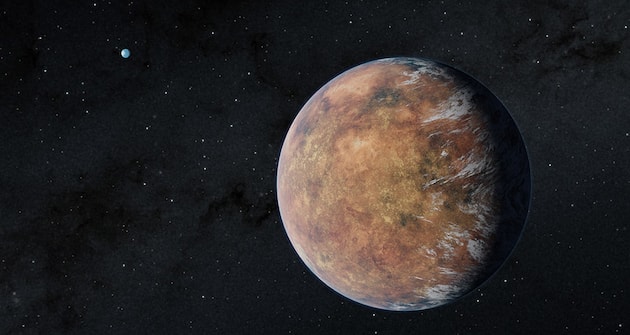Earth twins in a twin pack: Astronomers have discovered a second potentially habitable planet around the red dwarf TOI-700. About 100 light-years away, the exoplanet is almost as large as Earth and orbits at the edge of its star’s habitable zone. This is one of the few stars with several habitable worlds. Its two earth twins also offer the best opportunities for more precise observations, for example with the James Webb space telescope.
Astronomers have now discovered thousands of extrasolar planets, including many rocky Earth-like planets around nearby stars like Proxima Centauri and TRAPPIST-1 . In 2020, NASA’s TESS space telescope then detected an almost perfect Earth twin in our vicinity: The planet TOI-700d is about Earth-sized and orbits a red dwarf around 100 light-years away in the middle of the habitable zone. It may therefore have a mild climate and liquid water on its surface, unlike the other two planets in this system.
Now it turns out that the earth twin TOI-700d is not the only potentially life-friendly world around its star. In order to characterize the planetary system more precisely, Emily Gilbert from NASA’s Jet Propulsion Laboratory and her colleagues evaluated newer data from the TESS telescope for TOI-700. In doing so, they discovered another, much weaker signal in the red dwarf’s light curve, in addition to the three periodic shadows caused by the known planets.
Further analysis revealed: It is the transit signal of another, previously overlooked planet. Dubbed TOI-700e, this planet orbits between Earth twin TOI-700d and its inner, larger neighbor TOI-700c. “If the star was just a little closer or the planet was just a little bigger, we probably would have found TOI-700e in the first year of TESS,” says Gilbert. “But the signal was so weak that we needed another year of transit observations.”
The exciting thing about the new find: The newly discovered exoplanet is 95 percent the size of Earth and is therefore probably an Earth-like rocky planet. In addition, it orbits its star once in just under 28 days and is therefore still in the habitable zone of this red dwarf star. According to astronomers’ estimates, the planet receives 1.27 times the Earth’s solar radiation from its star – making it slightly warmer than Earth.
However, a temperate climate with liquid water on TOI-700e would still be entirely possible: “The irradiance on TOI-700e lies between Earth and Venus,” report Gilbert and her team. That makes this planet particularly exciting. Up until now it has been disputed whether Venus once had a habitable climate or whether it was a “vapor hell” from the start. “The TOI-700 system now offers a chance to clarify the Venus question on comparable exoplanets,” say the astronomers.
In any case, the TOI-700 system now includes two planets that offer potentially habitable conditions and are Earth-like. “This is one of only a few systems with multiple small planets in the habitable zone,” says Gilbert. Complementary observations with the Hubble Space Telescope also yielded no evidence of strong bursts of radiation from the red dwarf. Because such stellar flares release hard X-rays, they are considered a poor prerequisite for habitable conditions.
“All of this makes the TOI-700 system an exciting candidate for further observations,” says Gilbert. The TESS telescope will take a closer look at the star and its four planets this year. In addition, further observations with earth-based telescopes are already planned. (241st meeting of the American Astronomical Society, 2023; Astrophysical Journal Letters, accepted; arXiv:2301.03617)
Those: NASA
This article was written by Nadja Podbregar
Street dog Sammy was supposed to be handed over to his new owner at Munich Airport. But the six-month-old four-legged friend escaped. The search for him, which lasted more than a week, is now coming to a happy end.
In his autobiography “Spare” Prince Harry once again unpacks about his family. So far, as usual, she has been very silent. But public reluctance is deceptive. Position is taken in the background.
The original to this article “Astronomers discover Earth-like planets” comes from scinexx.
